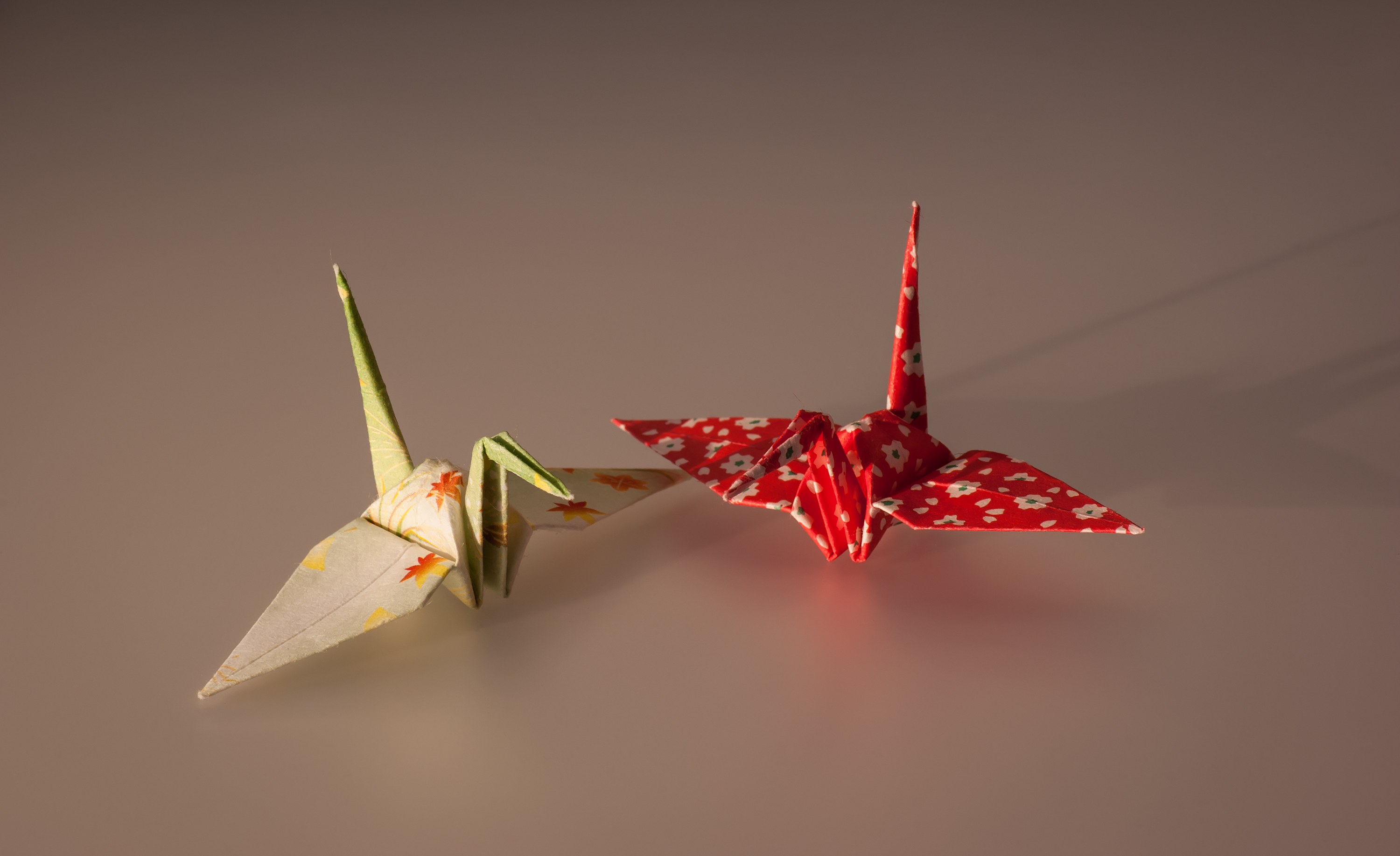Orizuru on:
[Wikipedia]
[Google]
[Amazon]
 The ''orizuru'' (折鶴 ''ori-'' "folded," ''tsuru'' " crane"), origami crane or paper crane, is a design that is considered to be the most classic of all Japanese
The ''orizuru'' (折鶴 ''ori-'' "folded," ''tsuru'' " crane"), origami crane or paper crane, is a design that is considered to be the most classic of all Japanese
''The Complete Story of Sadako Sasaki: and the Thousand Paper Cranes''
Since then, ''senbazuru'' and collective effort to complete it came to be recognized as synonyms of 'wish for recovering' or 'wish for peace'.

Video showing how to make an orizuru
Birds in art Origami
 The ''orizuru'' (折鶴 ''ori-'' "folded," ''tsuru'' " crane"), origami crane or paper crane, is a design that is considered to be the most classic of all Japanese
The ''orizuru'' (折鶴 ''ori-'' "folded," ''tsuru'' " crane"), origami crane or paper crane, is a design that is considered to be the most classic of all Japanese origami
) is the Japanese art of paper folding. In modern usage, the word "origami" is often used as an inclusive term for all folding practices, regardless of their culture of origin. The goal is to transform a flat square sheet of paper into a ...
.Jccc Origami Crane Project – Materials For Teachers & Students. MEANING OF THE ORIGAMI CRANE (n.d.): n. pag. Web. 16 Feb. 2017. In Japanese culture, it is believed that its wings carry souls up to paradise, and it is a representation of the Japanese red-crowned crane
The red-crowned crane (''Grus japonensis''), also called the Manchurian crane (; the Chinese character '丹' means 'red', '頂/顶' means 'crown (anatomy), crown' and '鶴/鹤' means 'crane'), is a large East Asian Crane (bird), crane among the ...
, referred to as the "Honourable Lord Crane" in Japanese culture. It is often used as a ceremonial wrapper or restaurant table decoration. A thousand orizuru strung together is called '' senbazuru'' (千羽鶴), meaning "thousand cranes", and it is said that if someone folds a thousand cranes, they are granted one wish."Senbazuru." Senbazuru , TraditionsCustoms.com. N.p., n.d. Web. 16 Feb. 2017.
The significance of ''senbazuru'' is featured in '' Sadako and the Thousand Paper Cranes'', a classic story based on the life of Sadako Sasaki, a ''hibakusha
' ( or ; or ; or ) is a word of Japanese origin generally designating the people affected by the atomic bombings of Hiroshima and Nagasaki by the United States at the end of World War II.
Definition
The word is Japanese, originally written i ...
'' girl at Hiroshima
is the capital of Hiroshima Prefecture in Japan. , the city had an estimated population of 1,199,391. The gross domestic product (GDP) in Greater Hiroshima, Hiroshima Urban Employment Area, was US$61.3 billion as of 2010. Kazumi Matsui has b ...
, and then later in a boo''The Complete Story of Sadako Sasaki: and the Thousand Paper Cranes''
Since then, ''senbazuru'' and collective effort to complete it came to be recognized as synonyms of 'wish for recovering' or 'wish for peace'.
Hiroshima Peace Memorial Museum
The Hiroshima Peace Memorial Museum is a museum located in Hiroshima Peace Memorial Park, in central Hiroshima, Japan, dedicated to documenting the atomic bombing of Hiroshima in World War II.
The museum was established in August 1955 with the ...
exhibits two paper cranes hand-crafted and presented to the museum by President Barack Obama
Barack Hussein Obama II (born August 4, 1961) is an American politician who was the 44th president of the United States from 2009 to 2017. A member of the Democratic Party, he was the first African American president in American history. O ...
when he visited the city in 2016, alongside his message.
Renzuru
The term refers to an origami technique whereby one folds multiple cranes from a single sheet of paper (usually square), employing a number of strategic cuts to form amosaic
A mosaic () is a pattern or image made of small regular or irregular pieces of colored stone, glass or ceramic, held in place by plaster/Mortar (masonry), mortar, and covering a surface. Mosaics are often used as floor and wall decoration, and ...
of semi-detached smaller squares from the original large square paper. The resulting cranes are attached to one another (e.g., at the tips of the beaks, wings, or tails) or at the tip of the body (e.g., a baby crane sitting on its mother's back). The trick is to fold all the cranes without breaking the small paper bridges that attach them to one another or, in some cases, to effectively conceal extra paper.
Typical ''renzuru'' configurations include a circle of four or more cranes attached at the wing tips. One of the simplest forms, made from a half-square (2×1 rectangle) cut halfway through from one of the long sides, results in two cranes that share an entire wing, positioned vertically between their bodies; heads and tails may face in the same or opposite directions. This is known as ''imoseyama''. If made from paper colored differently on each side, the cranes will be different colors.
This origami technique was first illustrated in one of the oldest known origami books, the ''Hiden Senbazuru Orikata'' (1797). (Updated diagrams from this early work can be found in a current book by Japanese origami author Kunihiko Kasahara.)
Folding the ''orizuru''
References
External links
{{commonscat, Origami craneVideo showing how to make an orizuru
Birds in art Origami